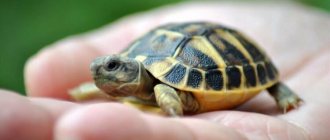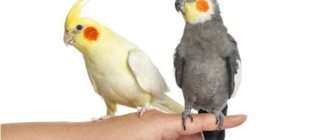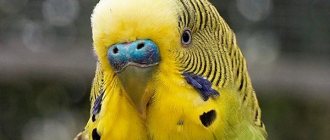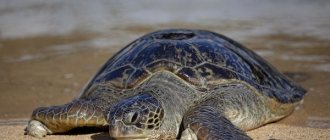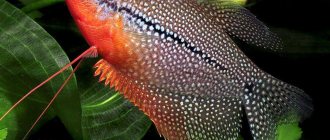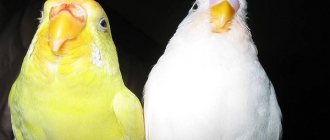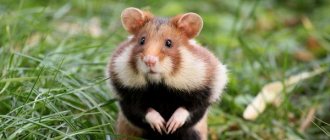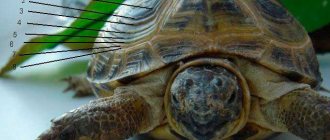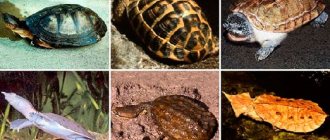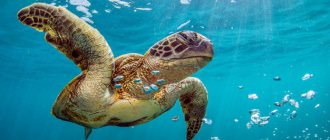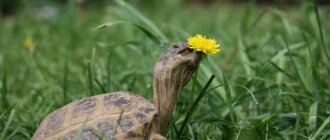TURTLES (Chelonia), a detachment of reptiles, are the only representatives of reptiles whose body is covered with a shell.
Found in all warm areas of the world. Several species are inhabitants of the seas and oceans, but mostly they are land and freshwater forms. Also on topic:
REPTIENTS
This group appeared in the Triassic ca. 200 million years ago. It is possible that turtles descended directly from cotylosaurs, the most primitive reptiles. Although there are few fossils to support this hypothesis, the extinct genus Eunotosaurus is a good candidate for being an evolutionary link. This animal had a flattened body and greatly expanded ribs.
Unlike their snake relatives, turtles were rarely worshiped and were never particularly feared. Indeed, they pose virtually no danger to human life. Unless a swimmer gets too close to a male leatherback turtle (Dermochelys coriacea) can be grabbed by its strong flippers and drowned. The fact is that in a state of strong sexual arousal, he is able to mistake any large object for a female.
Also on topic:
SYSTEMATICS OF ANIMALS
Anatomy.
The torso of turtles is enclosed in a shell, which also partially protects the head, neck and limbs. Its upper part, or carapace, covers the back and sides of the reptile, the lower, or plastron, covers the stomach. The shell is so strong that it can withstand 200 times the weight of the owner.
Typically, the inner layer of the shell is bone, and the outer layer is formed by hard horny tissue. Both layers consist of many elements tightly fitted to each other. The bone elements are called plates, and the horny ones are called scutes. The greater strength of the shell is partly ensured by the fact that the boundaries between the internal plates and the outer scutes do not coincide.
As the turtle increases in size, horny substance grows along the edges of each scute. If growth is interrupted by periods of hibernation, growth rings are clearly visible on the scutes, allowing one to estimate the age of the individual.
The ribs are fused to the shell, so the chest is motionless. As a result, the turtle's breathing resembles the diaphragmatic breathing characteristic of humans and other mammals. Special muscles pull the internal organs back, allowing the lungs to fill with air; then other muscles carry out the reverse process, compressing the lungs. Some aquatic species are not completely dependent on pulmonary respiration and are able to absorb oxygen also through the mucous membrane of the pharynx.
Differences between males and females (sexual dimorphism) are expressed differently depending on the species; sometimes they are completely invisible. A comparison of males and females of other species shows that the former have a longer and thicker tail, and the anus is located further from its base. This dimorphism is especially pronounced in huge sea turtles. Other sex differences concern the shape of the plastron, the color and size of the head, and the overall dimensions of the body.
Mating and egg laying.
Mating behavior begins with courtship, the forms of which are species specific. The male may butt and push the female while gently biting her. In large turtles, courtship is sometimes accompanied by loud grunting. Male painted turtles (Chrysemys picta) and ornamented turtles (Pseudemys) demonstrate affection in a special way: swimming backwards and dragging the female with them, they stroke or pat her on the face with the long claws of their front paws.
Mating can take place on land or in water. In this case, the penis, hidden at the base of the tail in a calm state, extends through the opening of the cloaca. Females of some turtle species can store viable sperm for a long time (this is also true of some other vertebrates), and one mating allows them to lay fertilized eggs over the next several years. However, their number decreases every year until a new portion of sperm is obtained.
Turtle eggs are oval or round, white or almost white. Females bury them in the ground to a depth not exceeding the length of their hind legs, or hide them in a pile of rotting plants. Most often these are well-lit places. Usually there is one clutch per year, but some sea turtles have as many as seven clutches in one breeding season. Depending on the type, eggs in a clutch range from one to 200.
The breeding process of domestic land turtles
To start raising reptiles at home, you will need certain conditions. The turtle owner needs to organize:
a strict weekly diet before wintering;
wintering (2 months), after which male and female individuals will become more active and energetic;
removal of gentlemen from females;
after waking up, increase the temperature in the terrarium, thereby forcing the sex hormones of the reptiles to work.
At 7-9 years old, females are ready for the first reproduction, males mature earlier and are ready to mate by the age of six. Males should be placed with females after 7 days from awakening. Males in the new territory will not be so aggressive and will be able to reproduce normally. The owner must closely monitor the cavaliers so that they do not cause serious injuries to each other during battle.
During mating, different types of turtles behave differently, some gently touch their shells, sending vibrations to the female, and more active males prefer to painfully bite the female on the paws and attack her shell.
The partner’s disposition will be immediately noticeable, and she will easily allow the candidate to approach her and will not be against the start of mating. During sexual intercourse, the male climbs onto the female, holding her with his paws. As soon as copulation ends, both partners let out a cry, which means the end of the act. Successful fertilization occurs after 2-3 sexual intercourse, so owners of reptiles should not rush to transfer the male to another terrarium.
While the pregnant turtle is bearing its offspring, the owner needs to take care of the following details:
prepare a container with sand in which the female will lay eggs;
Set up an incubator to keep small reptiles, about 2-3 months after birth. The temperature should not exceed 30 degrees, and the humidity should not be lower than 80%;
review the pregnant woman’s diet, double the amount of food, add vitamin and mineral supplements.
The approach of childbirth can be judged by the behavior of the female. She becomes more restless, refuses to eat and begins to dig holes in the sand.
As soon as the eggs are laid, it is better to move them to an incubator, where the necessary humidity and temperature conditions will be maintained.
Hatching.
The period of incubation and hatching is the most dangerous in the life of turtles; at this time, numerous enemies feast on their delicious eggs and still soft-bodied cubs. Mammals dig up clutches, and seabirds grab newly hatched turtles as they rush along the shore to the water. Once in the water, the babies become prey for voracious fish. At this time, a large number of lovers of their eggs and young usually accumulate near the breeding grounds of turtles. Depending on the species, it takes different times for the shell to harden, but usually at least several months. After this, the turtles become relatively inaccessible to predators.
In nature, turtles grow quickly. There is a known example when, even in captivity, Galapagos elephant tortoises (Geochelone elephantopus), starting from about 11 kg, annually gained the same amount until they weighed more than 100 kg. Many small species reach sexual maturity between the ages of 2 and 11 years.
Turtle: description, characteristics
- Different species are adapted to their habitat - some prefer water, others live on land. Aquatic reptiles are predators. Their diet includes fish, shellfish, and invertebrates. In nature, the land turtle feeds primarily on plant foods.
- Turtles are long-lived . The average life expectancy is 150-200 years. These animals have inhabited planet Earth for more than 200 million years. In addition to bone shelter from adverse factors, nature has endowed turtles with good eyesight and excellent hearing. When cold weather sets in, turtles go into hibernation.
Elephant
Lifespan.
No known vertebrate lives as long as turtles. Most of the information suggesting that their lifespan is slightly more than 50 years refers to individuals kept in captivity. Some species certainly live much longer. The Carolina box turtle (Terrapene carolina) found in Rhode Island was almost certainly 130 years old. The maximum period is considered to be approx. 150 years, but it is quite possible that the actual life expectancy of individual individuals is much longer.
Pregnancy period
After mating, individuals should be immediately placed in separate terrariums. The fact is that after intercourse, males often show aggression. So, let's continue to look at how turtles reproduce. The female bears the eggs for about two to three months. During this period she behaves restlessly. Experienced zoologists recommend including fresh foods rich in vitamins in her diet. The temperature in the terrarium must be maintained within 22–26 degrees Celsius. And on land you should prepare a separate place for laying eggs. To do this, dig a hole in the soil or sand and place a small container with sphagnum moss there so that it is level with the land. After laying eggs, the female forgets about her offspring.
Nutrition.
Turtles in general can be called omnivores, although some species prefer plant food, others animal food, and still others eat everything. A strictly specialized diet is rare. Some aquatic turtles only feed underwater. Very young individuals require daily feeding, but this is not necessary for adults. In fact, once well fed, they can go months, and possibly years, without food.
Turtles have no teeth, and the sharp edges of their jaws are capable of biting food, but not chewing it. Tough, fibrous plants are difficult for turtles to handle, and animal meat sometimes has to be torn into pieces using the claws on the front paws. Some species have horny ridges inside the mouth, which allow them to crush prey protected by hard coverings.
Egg care
You cannot leave the eggs in the aquarium. It must be carefully transferred, without turning it over, into an incubator with a temperature of +25...30°C. You can also put the eggs in a jar filled with sand and place them near the central heating pipes.
If it was not possible to observe the reptiles and there are doubts whether the clutch is fertilized, you can consider it. On the first day, a fertilized egg is homogeneous when exposed to light, with a dark dot in the center. After 2-3 months the embryo is visible. If there are no inclusions, the cubs will not appear. It is not recommended to change the position of the eggs unless necessary.
Turtles hatch in 2-5 months. Their size on average is 28-32 mm in length and 30 mm in width, and their weight reaches 4-6 grams. For at least a year, young reptiles should not be allowed into an aquarium where adults are kept, which can injure babies. Females lack maternal instinct.
When the turtles completely get rid of the yolk sac, they should be given the following food:
- chopped fish;
- bloodworms, daphnia, gammarus;
- shrimp.
This food contains a lot of vitamin D3 and calcium. These microelements prevent the occurrence of respiratory diseases and eye problems. An island of soil is needed, well illuminated by a special lamp.
Breeding turtles in captivity is possible if done responsibly
It is important to monitor the condition of reptiles and the conditions in which they are kept.
Particular attention should be paid to fragile young turtles
Sense organs and higher nervous activity.
Turtles are good at distinguishing odors at close range and, judging by some observations, use their sense of smell when choosing food. Vision is also well developed: these animals can be taught to recognize contours and colors. Both the shell and scaly skin have tactile sensitivity, and the giant tortoise even feels the pressure of a straw that is passed along its massive carapace. Although it has long been known that turtles are sensitive to vibrations transmitted through the soil, their ability to perceive airborne sound waves has long been controversial. Today the existence of at least weak “ordinary” hearing in them is considered proven.
Compared to other reptiles, turtles are very smart. They easily learn to follow their owner, seem to enjoy the attention they receive, and get used to a certain routine well. Apparently, some individuals are smarter than others. For example, among six Agassi gophers (Gopherus agassizi) living together, one individual, of its own volition, climbed up an inclined plane onto a platform and slid down the other side down a metal chute. She obviously enjoyed this activity and repeated it for hours on end. But in some situations, turtles are surprisingly slow-witted. For example, they may spend a lot of energy climbing over an obstacle that is not difficult to get around; or for a long time they try to squeeze through a gap that is much smaller in size.
Cheloniidae
(sea turtles). Five or six species of the family are large reptiles with limbs resembling oars or flippers. These are exclusively aquatic animals, coming ashore only to lay eggs or bask in the sun. It is very difficult for them to move on land. At least one species is found in all warm oceans.
The green (soup) turtle (Chelonia mydas) is the most famous of the sea turtles. It is distributed throughout the globe, and it is from it that the famous turtle soup is prepared. Previously, these reptiles were essentially mercilessly exterminated, often killing the females just before laying eggs.
Wintering
Another method is cooling. Reptiles are placed one at a time in cloth bags and placed in sphagnum moss. Boxes with turtles should be taken to a cool room (from 0 to 12 degrees). To prevent dehydration, the filler should be sprayed with water from a spray bottle every day. As a rule, artificial wintering lasts about four weeks. The turtle boxes can then be moved back into the house. After two days, the animals can be placed in a terrarium and a heat lamp can be turned on, thereby increasing the duration of daylight hours to 16 hours. It is very important to include foods rich in vitamin E in your pet’s diet.
Dermochelyidae
(leatherback turtles). The leatherback turtle (Dermochelys coriacea) is the only living species of this family. This giant can reach a mass of more than 680 kg with a front flipper span of 3.6 m. The leathery shell bears 7 longitudinal ridges on the dorsal side and 5 on the ventral side. Although the range of these turtles covers all warm oceans, they are the rarest among the widespread marine species of the order. The question of the systematic position of the group remains controversial. It was allocated to a special suborder Athecae (scutellae), but most experts agree only on the rank of superfamily.
Trionychidae
(three-clawed). These turtles are easily recognized by their soft, leathery shell without any scutes. They have a flat body, an elongated conical snout and legs with webbed swimmers. These are one of the fastest turtles, moving quickly both in water and on land. The long neck allows it to grab food and bite the enemy painfully, even if they are at a considerable distance. The claws of large individuals can leave deep scratches. Representatives of certain species tolerate captivity well, living in it for up to 20 years or more (the record is 25). Some three-clawed turtles are highly prized for their tasty meat. The largest of their 20 species, the large soft-shelled turtle (Pelochelys bibroni) lives in Southeast Asia; its shell reaches a length of more than 1.2 m. Representatives of this family live in North America, Africa, Southeast Asia, the Malay Archipelago and New Guinea. Three species are found in the United States.
Pelomedusidae, Chelidae
(suborder side-necked turtles: pelomedus and snake-necked). Representatives of these two families differ in the way the neck bends when the head is pulled under the edge of the shell: if in other turtles the neck bends in a vertical plane, then in them it bends in a horizontal plane, which is explained by the special structure of the spine. Side-necks live in the Southern Hemisphere or the regions closest to it and are not found in North America, Europe and Asia. Both families unite approx. 50 types. The most bizarre of all turtles, the matamata (Chelus fimbriata) from South America, is a snake-necked turtle. Her head is covered with many outgrowths sticking out in different directions. The Australian snake-necked turtle (Chelodina longicollis) has a thin neck almost as long as its shell.
Chelydridae
(snapping turtles). The family includes only 2 species, of which the best known is the snapping turtle (Chelydra serpentina). It is an aquatic reptile native to much of North America and northwestern South America, abundant in southeastern Canada and the eastern half of the United States, where it is highly prized as a food item. Snapping turtles are unfairly blamed for killing large numbers of fish and waterfowl. The weight of these animals often reaches 13.6 kg. When pulled out of the water, they can bite painfully.
Another species, the snapping turtle (Macrochelys temmincki) is one of the giants of the order, reaching a mass of approx. 90 kg. Not only are they the heaviest of its freshwater species, but they are also the most water-bound of the North American turtles. They are found in the southeastern United States, mainly in the lower Mississippi. Being slow, the snapping turtle lures prey with the help of a fleshy outgrowth of the bottom of the mouth, which moves in its open mouth like a worm.
Mating games
Turtles are no strangers to demonstrative displays of affection. Males become very active during the mating season. Many people make the mistake of considering turtles to be silent creatures. After all, males, when courting their darlings, often make sounds similar to yapping. And females have the right to express their opinion with their voice.
Usually males challenge rivals to fights. And during the period of “fighting”, weak animals can be injured and die. So it would be a huge mistake to consider turtles as calm and good-natured animals.
The male is not so loyal to his chosen one either. Seeing a female, it begins to shake its head up and down. But he does not intend to wait for her to reciprocate her feelings. Having performed a ritual dance of recognition, the male runs to the turtle and hits it hard with his head in the shell. In addition, he bites the reptile's paws until it is eventually subdued.
Like many other animals, turtles also have mating games. They are characteristic of both red-eared and land species. Basically, this is manifested in the behavior of the male, who in this way tries to win the gratitude of his bride, whom he has chosen.
Boys become very active. They can swim in front of the female, tickling her cheeks with their hind legs, make certain sounds similar to yapping, and do other unusual things. Females, in turn, mostly watch all this with enviable calm. But some individuals can still respond with the same yelp.
Of particular note are the turtle fights. They take place between males for the right to fertilize one or another female. Contrary to popular belief that turtles are cute and clumsy creatures, they are very aggressive in battles and can cause extremely serious damage to their relatives, including life-threatening injuries.
We suggest you read: What does a red-eared turtle need to keep at home?
It is noteworthy that if the male has already chosen the female and won the fight for her, then the lady of his heart has no choice. After the mating games, the groom begins the mating process, and he does not care at all whether the appropriate consent has been received from the female. If she resists, then physical force is used - he hits his head in the shell, can “unfold” his paws, and bites. This continues until the female allows him to approach her.
Mating of land turtles and red-eared turtles is quite an interesting sight. With the right approach, these pets can be reproduced at home.
Kinosternidae
(mud turtles). Turtles of this family, which includes 21 species, usually live at the bottom of rivers and lakes. The group's range extends from southeastern Canada through the central and eastern United States to South America. The eight species of mud turtles found in the United States have small, fleshy “whiskers” on their chins that help distinguish them from other members of the order.
The most famous member of the family, the common musk turtle (Sternotherus odoratus), is common in the waters of the eastern United States. Its length does not exceed 13 cm, but it greatly annoys local fishermen, as it often gets hooked, and when it is picked up, it secretes a stinking secretion from the musk glands. In addition, she is warlike and bites painfully.
Trailing turtles (genus Kinosternon) are found almost exclusively in the southeastern United States. They avoid deep bodies of water and come to land from time to time. The range of the Pennsylvania turtle (Kinosternon subrubrum) extends from the southeast of the country along the Atlantic coast to the southwestern tip of Connecticut.
Testudinidae
(land turtles). This family includes approx. 40 species of turtles found on every continent except Australia. This includes the relatively small Mediterranean tortoise (Testudo graeca), the giant elephant tortoise (Geochelone elephantopus) from the Galapagos Islands, and some bizarre African species. Thus, in African kinix tortoises (genus Kinixys), the back part of the carapace is movably connected to the front; the elastic tortoise (Malacochersus tornieri) from Tanzania and Kenya has a soft, flattened shell made of thin bony plates and can hide in narrow rock crevices in a moment of danger. The only members of this family found in the United States are in the genus Gopherus; they live in the southern part of the country.
In the 19th century Galapagos elephant tortoises were taken on whaling ships as supplies of meat for sailors. The capture of millions of individuals has undermined the population so much that it is in danger of extinction.
What do turtles eat in the wild?
- Turtles are omnivores. The diet of sea and freshwater turtles consists of fry of fish, crustaceans, mollusks, and tadpoles. Large individuals hunt large fish and frogs. A hungry turtle is capable of eating a defenseless relative.
- Land turtles eat mainly plant foods. Animals eat plant stems, vegetables, fruits, and mushrooms. Under favorable conditions, it is not averse to feasting on small insects and small living creatures from reservoirs.
Nutrition
- Rotten food is easier to chew, so turtles do not refuse rotten fish and spoiled fruits.
- At home, pets replace their usual food with algae, salad leaves, vegetables, aquarium fish and snails.
Emydidae
(freshwater turtles). This is the largest family of the order, uniting more than a third of all its species. They are common to the northern continents, also found in northern South America and Africa and are very diverse in size and body shape.
The painted turtle (Chrysemys picta), which is distributed throughout the United States, is one of the most famous members of the family. It often reaches high numbers even in small ponds. Box turtles (Terrapene) are also a common genus, but are not found in the western United States. They are mostly land animals; the movable elements of the plastron enable them to tightly close all the openings of the shell, like flaps. Ornamented turtles (Pseudemys) inhabit the southeastern United States.
What does a turtle without a shell look like and what is it made of?
- Another unique feature of the turtle is the presence of an internal and external skeleton. The turtle's shell is tightly fused with the ribs and vertebrae; without it, the animal's life is not possible. The presence of a bone structure limits the development of the trunk muscles.
- The thoracic region is lined with oblong vertebrae that pass into the sternum. 33 vertebrae in the turtle's tail , which provide it with mobility. The hip bones are very short and are an integral part of the frame and spine.
- The freshwater turtle is found in nature with a frame made of soft tissues covered with rough skin. Relatively light weight facilitates rapid movement and performs protective functions when encountering danger.
Without a shell
